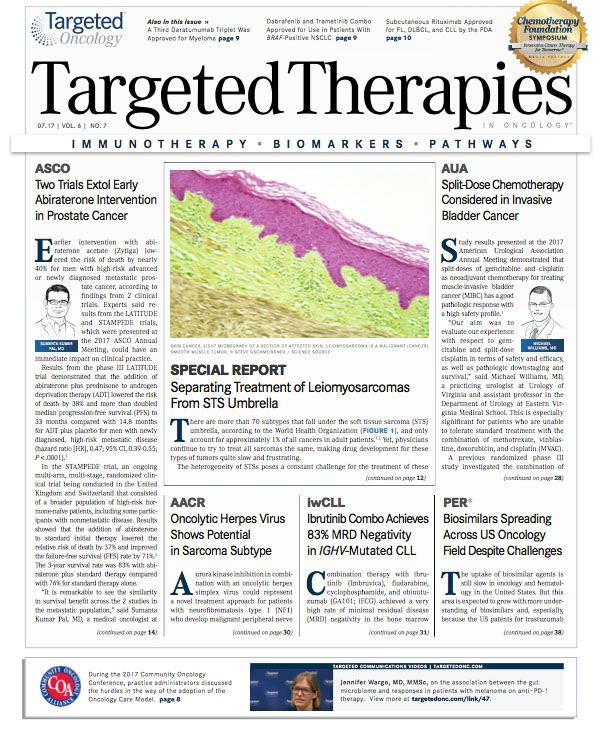Duvelisib/FCR Achieves Higher Rate of MRD Negativity, Responses in Young CLL Patients
Duvelisib, a PI3K-delta/gamma inhibitor, in combination with fludarabine, cyclophosphamide, and rituximab showed high rates of responses and bone marrow minimal residual disease negativity in younger patients with previously untreated chronic lymphocytic leukemia.
Matthew S. Davids, MD
Duvelisib (IPI-145), a PI3K-delta/gamma inhibitor, in combination with fludarabine, cyclophosphamide, and rituximab (Rituxan; FCR) showed high rates of responses and bone marrow minimal residual disease (BM MRD) negativity in younger patients with previously untreated chronic lymphocytic leukemia (CLL), according to findings from a phase Ib/II study. The rate of best response achieved and bone marrow MRD negativity was 68% overall.
“Duvelisib/FCR is for the frontline treatment of younger, fit patients, and we’re seeing high rates of BM MRD negativity with reasonable tolerability,” Matthew S. Davids, MD, MMSc, associate director, Center for CLL, Dana-Farber Cancer Institute, and assistant professor of medicine, Harvard Medical School, stated in an interview withTargeted Therapies in Oncologyduring the 2017 International Workshop on CLL (iwCLL).
Patients with untreated CLL or small lymphocytic leukemia between the ages of 18 and 65 with an ECOG performance status of 0 or 1 were eligible for enrollment. The primary endpoints were safety and rate of complete remission (CR) with BM MRD negativity at 2 months after treatment with FCR. The phase Ib component used a standard 3 + 3 design with patients receiving 25 mg of duvelisib daily (n = 6) or twice daily (n = 6). In both cohorts, patients received 1 week of duvelisib followed by up to 6 cycles of FCR and then 2 years of continued duvelisib. In the phase II expansion, all patients were treated with duvelisib twice a day. The median age was 55 years (range, 45-65). Eight patients harbored del(11q) and 3 had del(17p), 2 of which also had a TP53 mutation. More than half (56%) of the patients had unmutated IGHV and 59% were ZAP-70positive. The objective response rate in 31 evaluable patients was 94%, which included 12 patients (39%) with a CR or CR with incomplete bone marrow recovery and 17 (55%) with a partial response (PR). Eleven of the 12 patients who achieved CR and 10 of the PRs also had BM MRD negativity.
After 3 cycles, 18 patients (58%) had achieved BM MRD negativity, and 19 (61%) had achieved it by 2 months after FCR treatment. The rate of CR and BM MRD negativity was 35% and the rate of PR and BM MRD negativity was 32%.
Only 1 dose-limiting toxicity was noted: a grade 3 febrile neutropenia with the once-daily dose of duvelisib. The recommended phase II dose of duvelisib when given in combination with FCR was 25 mg twice daily.
Grade ≥3 hematologic adverse events (AEs) in all enrolled patients included grade 3 neutropenia in 6% and grade 4 in 41%, grade 3 thrombocytopenia in 3% and grade 4 in 28%, and grade 3 anemia in 16%. Nonhematologic AEs (all-grade) included nausea (69%), fever (38%), fatigue (31%; grade 3, 3%), anorexia (28%), diarrhea (28%; grade 3, 3%), transaminitis (31%; grade 3/4, 28%), vomiting (16%; grade 3, 3%), pruritus (9%; grade 3, 3%), arthritis (9%), and cytomegalovirus (CMV) reactivation (6%).
Serious AEs included pneumonia in 6 patients, including 3 cases of pneumocystis jiroveci pneumonia despite prophylaxis, the authors noted. Other serious toxicities included transaminitis (grade 3, n = 5; grade 4, n = 4), colitis (grade 2, n = 1; grade 3, n = 1), febrile neutropenia (grade 3, n = 6), pruritus (grade 3, n = 1), CMV infection (n = 1), and metastatic melanoma (n = 1).
Fifteen patients discontinued treatment due to toxicities: 5 from grade 4 transaminitis; 4 from prolonged cytopenia; 3 due to autoimmune cytopenias including autoimmune hemolytic anemia, neutropenia, and red cell aplasia; and 1 each due to grade 3 rash and grade 3 amylase increase. One patient withdrew due to unspecified toxicities.
Reference:
Davids MS, Kim HT, Hanna J, et al. A phase Ib/II study of duvelisib in combination with FCR (dFCR) in previously untreated, younger patients with CLL. Poster presented at: 2017 International Workshop of Chronic Lymphocytic Leukemia; May 12-15, 2017; New York, NY. Abstract 104.

Advances in Subsequent Therapies Shake Up Sequencing of ccRCC Treatment
April 25th 2024With the approval of belzutifan and other newer data for treating patients with recurrent renal cell carcinoma, the state of subsequent therapies is advancing beyond the reuse of frontline options with impacts on duration of response and quality of life.
Read More
Ornstein Advises on Starting Dose and Management of Lenvatinib in RCC
April 21st 2024During a Case-Based Roundtable® event, Moshe Ornstein, MD, MA, provided guidance on dosing and toxicity concerns in a patient treated with lenvatinib plus pembrolizumab for advanced renal cell carcinoma.
Read More